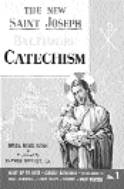Don't let the inexpensive price on these books fool you. These catechisms are worth their weight in gold. Based on the Baltimore Catechism that was first approved by the Archbishop of Baltimore, James Cardinal Gibbons, in 1885, these books are inviting with their illustrations and easy-to-use format.
The New Saint Joseph version goes beyond the simple question-and-answer format of the original catechism. It incorporates Holy Scripture with each lesson and includes discussion questions, a fill-in-the-blank section, and suggested Bible readings at the end of each lesson. The pictures themselves are great teaching tools as they illustrate spiritual truths.
Memorizing the questions and answers of the catechism provides the opportunity to build a religious foundation. This basic Catholic doctrinal foundation gives children the tools necessary to defend their faith when they are old enough to apply reason and logic (much like memorizing the alphabet before learning to read and analyze literature).
In addition to memorization of the questions and answers, I copy the accompanying Scripture on 3" x 5" cards. The children and I memorize the Scripture verses, then discuss how it applies to the week's lesson. I am careful to emphasize the Scripture as a part of a whole picture rather than putting too much weight on individual verses. We review the Q&A and Scripture each day for a week, before moving on to the next lesson.
First Communion Catechism (65 pages) - This is a simple book to be used in the child's First Communion year (usually 2nd grade). It emphasizes Jesus in the Eucharist and the sacrament of Reconciliation. There are discussion questions at the end of each of the 11 lessons, but the fill-in-the-blank and Scripture references are not included in this book as they are in books No. 1 and No. 2. The book begins with prayers for everyday and ends with an explanation of the Holy Mass.
No. 1 - The Baltimore questions and answers are divided into three parts: The Creed, The Commandments, and The Sacraments and Prayer. Usually used in grades 3 to 5. 192 pages.
No. 2 - Has the same division and order as book No. 1, but the lessons are more in-depth for the older student. Usually used in grades 6 to 8. 264 pages.
[Maureen Wittmann]










